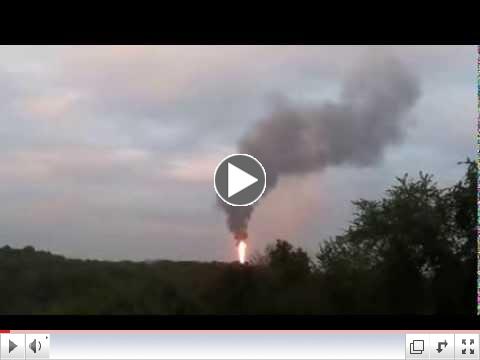
Of Public Health and Shale Extraction in Pennsylvania
By Ann Pinca
Earlier this week, Governor Corbett released a new election campaign advertisement touting jobs, millions of dollars for local communities and the state, even lower energy bills for families and seniors. "And thanks to Tom Corbett," says the ad, Pennsylvania is now America's "second largest producer of natural gas and the benefit to Pennsylvanians has been remarkable."
Unfortunately, what Gov. Corbett's ad doesn't mention are the "remarkable" negative impacts experienced by many Pennsylvanians living within the boundaries of drilling areas. In the eager rush to drill Pennsylvania, attention to the ill effects - including health impacts on citizens - got brushed aside.
 | |
How's the Weather? Environmental Health Project on Air Exposure from Fracking Created by SWPA-EHP
|
Last week, the Southwest Pennsylvania Environ-
mental Health Project (SWPA-EHP), founded to assist Washington County residents impacted by the shale extraction industry, also released something new: a short video and guide to help those
living near active shale extraction areas to better understand pollution in relation to weather so they know when it is safe to be outside or when it's better to stay inside with the windows closed tight. That such a guide is necessary in what are often rural areas of Pennsylvania, is, well, rather remarkable in its own sad way.
Amazingly, the ultimate health impacts of Pennsylvania's energy revolution remain unknown even after years of intense shale extraction development in the Keystone State, because no studies were made to determine what those impacts might be. A recent conference at Widener Law in Harrisburg brought to light some of those research shortcomings. Dr. Lynne R.
Goldman, Dean of the School of Public Health and Health Services at the George Washington University, discovered this lack of research while looking for information for her presentation. After finding only a few small case studies related to hydraulic fracturing in academic sources and the National Institutes of Health (NIH), Goldman determined, "The bottom line is that there's very little actual research on health effects of this activity in the scientific literature."
 |
An active well pad in Lycoming
County.
IMAGE: ANN PINCA
|
One exception mentioned by Goldman was research done by the National Institute for Occupational Safety and Health (NIOSH). Goldman remarked that NIOSH had a well-organized research agenda for hydraulic fracturing, which especially addressed the dangers of silica, the sand used during the fracturing process.NIOSH has posted an alert specific to hydraulic fracturing, which warns workers of the dangers of exposure to silica.
Goldman concluded that although there are a number of health hazards associated with the technology of hydraulic fracturing, we actually know very little about the public health consequences. Goldman also noted that there is limited funding to attract researchers and consequently, limited engagement with the academic community. To date, most studies have been made only in reaction to reported problems, with limited effort to identify those problems.
Two other speakers, Patricia Salkin, Esq., Dean and Professor of Law at Touro Law Center, and Pamela Ko, Assistant Professor of Law in the School of Management at the Sage Colleges, discussed Health Impact Asessments (HIA). Making it clear that HIA's are not meant to stop projects but are instead meant to be used as tools to make better informed decisions, the speakers presented two HIA's in Pennsylvania as examples, although neither were related to drilling or hydraulic fracturing.
They did discuss one hydraulic fracturing-related HIA that was implemented in an intense area of drilling activity, Garfield County, Colorado. The HIA was commissioned by local officials after citizens living there made the case for its need. However, industry pressure eventually subdued the local government support and the HIA's funding was stopped before the study could be completed.
Dr. Bernard Goldstein of the National Academies of Science Institute of Medicine also spoke on public health at the
 | |
A methanol tank near a Lycoming County well pad.
IMAGE: ANN PINCA
|
Widener conference. Stating that transparency is important to public health, Goldstein pointed out the lack of transparency in Pennsylvania's oil and gas legislation Act 13, calling it "environmental recidivism" that's taking us back to "the bad old days." Transparency problems Goldstein cited included incomplete FracFocus reporting, the proprietary chemical issues physicians face when treating patients, and the industry's exemption from reporting unintentional or naturally occurring chemicals that result from hydraulic fracturing.
Goldstein also mentioned that while Act 13 provides funds to several agencies, including a three-year $20 million grant to fund natural gas-powered cars, "not one penny goes to the Pennsylvania Department of Health," despite an initial recommendation that provided for an annual $2 million to support a public health registry. In Bernstein's opinion, "We're going too fast ... we're just drilling too quickly without slowing down enough to do the right kind of job."
It's a concern apparently echoed by the American Nurses Association, whose 2012 House of Delegates passed a resolution calling for its members to become educated in health issues related to fossil fuels and also called for "a national moratorium on new permits for unconventional oil and gas extraction (fracking) throughout the country until human and ecological safety can be ensured."
With the pass Pennsylvania's Act 13 made on health studies, other organizations have stepped up to study health impacts, but funding remains a hurdle. In August 2012, Guthrie Health and Geisinger Health System announced they would collaborate on a large-scale study of Marcellus Shale impacts using data from patient records. However, as of June this year, only $1.3 million has been raised toward the estimated $25 million needed for the study, which could take 15-20 years to complete.
Meanwhile, smaller health institutes across Pennsylvania continue to collect and document data on patients exhibiting possible shale extraction-related health impacts. Ranging from sinus problems, difficulty in sleeping, and gastrointestinal problems documented by Dr. Poune Saberi in Bradford County to nosebleeds, rashes, coughing, vomiting, and abdominal pain reported in a June 2013 report from western Pennsylvania's SWPA-EHP, the evidence is consistent with the findings of other studies though definitive links remain elusive.
 | |
Black smoke billows from the MarkWest Houston Gas Plant on 9-21-13, as posted on You-Tube
|
One finding is that air pollution from gas extraction processes, especially when in the proximity of larger operations such as processing plants and compressor stations, can be more of a consideration than water contamination. And that's where the SWPA-EHP weather guide comes in. Raina Rippel, executive director of SWPA-EHP, recently relayed this information to concerned residents in Butler County.
Instructing the group in what they can do to protect themselves, Rippel told them that she would be concerned about air pollutants within a half-mile of the source. That's something to ponder when most, if not all, required setbacks for gas infrastructure in Pennsylvania are considerably less than a half mile's 2,640 feet. With Penn State University Dr. Terry Engelder's recent comment that 80,000 wells could eventually be drilled in Pennsylvania, that creates the potential for a whole lot of bad air most likely very close to a lot of people.
At this year's Shale Insight conference in Philadelphia, keynote speaker Newt Gingrich urged the gathering of industry representatives to forge on, despite "entire institutions dedicated to slowing you down." Yet those concerned with the health impacts inflicted on people living in active gas operation areas know that transparency and slowing down is exactly what we need to gather necessary information to protect human life.
If our Governor could see fit to take the time needed to be sure we "get it right" with shale extraction as far as health impacts on Pennsylvania citizens are concerned, then we might actually have something for which to say "thank you" to Tom Corbett.
 |
Drilling takes place on a well pad near homes in Tioga County.
IMAGE: ANN PINCA
|
|